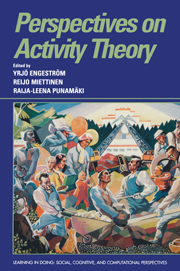Book contents
- Frontmatter
- Contents
- List of contributors
- Series foreword
- Introduction
- Part I Theoretical issues
- Part II Language and its acquisition
- 11 The expanded dialogic sphere: Writing activity and authoring of self in Japanese classrooms
- 12 Improvement of schoolchildren's reading and writing ability through the formation of linguistic awareness
- 13 Psychomotor and socioemotional processes in literacy acquisition: Results of an ongoing case study involving a nonvocal cerebral palsic young man
- Part III Play, learning, and instruction
- Part IV Technology and work
- Part V Therapy and addiction
- Author index
- Subject index
13 - Psychomotor and socioemotional processes in literacy acquisition: Results of an ongoing case study involving a nonvocal cerebral palsic young man
Published online by Cambridge University Press: 05 June 2012
- Frontmatter
- Contents
- List of contributors
- Series foreword
- Introduction
- Part I Theoretical issues
- Part II Language and its acquisition
- 11 The expanded dialogic sphere: Writing activity and authoring of self in Japanese classrooms
- 12 Improvement of schoolchildren's reading and writing ability through the formation of linguistic awareness
- 13 Psychomotor and socioemotional processes in literacy acquisition: Results of an ongoing case study involving a nonvocal cerebral palsic young man
- Part III Play, learning, and instruction
- Part IV Technology and work
- Part V Therapy and addiction
- Author index
- Subject index
Summary
Introduction
The case study presented here is one of the first six to be involved in an Augmentative and Alternative Communication (AAC) research project led by Professor Siegfried Schubenz. Its aim is to examine new communication forms and approaches with physically severely disabled students.
The intervention strategy that we use is derived from psychologicaleducational therapy (Pädagogisch–Psychologische Therapie; see Schubenz, 1993; Pilz, 1982; Schlösser, 1980). Grounded in activity theory, this therapy integrates psychotherapeutic and educational aspects into a model of ambulant psychosocial intervention.
The AAC medium most widely used in our work is Blissymbolics (Bliss, 1965). This is a picto- and ideographic symbol communication system consisting of 26 basic “symbol elements” (McDonald, 1980, p. 21). These elements are combined according to standardized rules to form terms and can be grammatically arranged into sentences.
In order that the symbols be understood by persons not fluent in Bliss, the meaning of each symbol is also written in traditional orthography (TO) above the symbol. Currently there are about 3,000 standardized Blissymbols worldwide.
In order to communicate with the help of such a nonverbal symbolic communication system (Musselwhite & St. Louis, 1982), or aided system (Lloyd, 1985; Lloyd, Quist, & Windsor, 1990), not only the meaning of the symbols but also ways to produce them have to be learned. If writing or drawing are out of the question, some form of indicating or coding strategy becomes necessary as a substitute, using the remaining range of voluntary movements.
- Type
- Chapter
- Information
- Perspectives on Activity Theory , pp. 206 - 228Publisher: Cambridge University PressPrint publication year: 1999



